

Viable system model. Overview[edit] The model was developed by operations research theorist and cybernetician Stafford Beer in his book Brain of the Firm (1972).[1] Together with Beer's earlier works on cybernetics applied to management, this book effectively founded management cybernetics.
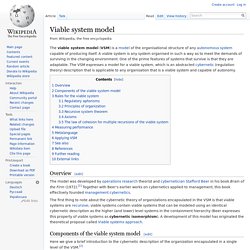
The first thing to note about the cybernetic theory of organizations encapsulated in the VSM is that viable systems are recursive; viable systems contain viable systems that can be modeled using an identical cybernetic description as the higher (and lower) level systems in the containment hierarchy (Beer expresses this property of viable systems as cybernetic isomorphism). A development of this model has originated the theoretical proposal called Viable systems approach. Components of the viable system model[edit] Here we give a brief introduction to the cybernetic description of the organization encapsulated in a single level of the VSM.[2] Principal functions of the VSM Rules for the viable system[edit] These principles are:
Wicked problem. "Wicked problem" is a phrase originally used in social planning to describe a problem that is difficult or impossible to solve because of incomplete, contradictory, and changing requirements that are often difficult to recognize.
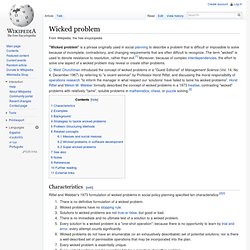
The term "wicked" is used to denote resistance to resolution, rather than evil.[1] Moreover, because of complex interdependencies, the effort to solve one aspect of a wicked problem may reveal or create other problems. C. West Churchman introduced the concept of wicked problems in a "Guest Editorial" of Management Science (Vol. 14, No. 4, December 1967) by referring to "a recent seminar" by Professor Horst Rittel, and discussing the moral responsibility of operations research "to inform the manager in what respect our 'solutions' have failed to tame his wicked problems". Horst Rittel and Melvin M. Wicked Problems. If you work in an organisation that deals with social, commercial or financial planning - or any type of public policy planning - then you've got wicked problems.
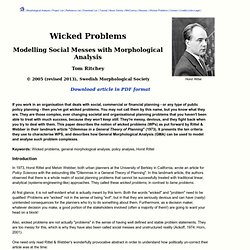
You may not call them by this name, but you know what they are. They are those complex, ever changing societal and organisational planning problems that you haven't been able to treat with much success, because they won't keep still. They're messy, devious, and they fight back when you try to deal with them. This paper describes the notion of wicked problems (WPs) as put forward by Rittel & Webber in their landmark article "Dilemmas in a General Theory of Planning" (1973).
It presents the ten criteria they use to characterise WPS, and describes how General Morphological Analysis (GMA) can be used to model and analyse such problem complexes. Dunning–Kruger effect. Cognitive bias about one's own skill The Dunning–Kruger effect is a hypothetical cognitive bias stating that people with low ability at a task overestimate their own ability, and that people with high ability at a task underestimate their own ability.

As described by social psychologists David Dunning and Justin Kruger, the bias results from an internal illusion in people of low ability and from an external misperception in people of high ability; that is, "the miscalibration of the incompetent stems from an error about the self, whereas the miscalibration of the highly competent stems from an error about others".[1] It is related to the cognitive bias of illusory superiority and comes from people's inability to recognize their lack of ability. Without the self-awareness of metacognition, people cannot objectively evaluate their level of competence.
Original study[edit] Later studies[edit] Mathematical critique[edit] Systems Thinking and Lean: Complementary or Competitive Approaches? Open University - Systems. Primer [ProjectsISSS] General Systems Theory by Ludwig von Bertalanffy “Modern science is characterized by its ever-increasing specialization, necessitated by the enormous amount of data, the complexity of techniques and of theoretical structures within every field. Thus science is split into innumerable disciplines continually generating new subdisciplines. In consequence, the physicist, the biologist, the psychologist and the social scientist are, so to speak, encapusulated in their private universes, and it is difficult to get word from one cocoon to the other…” Presidential Address 1996 by Ervin Laszlo “We have arrived at a watershed in the history of humanity.
A Nation at Risk by Bela H. What can systems theory do for me? - systems theory employment. Tell me all about Systems Theory, and how it can solve all my problems. I'm becoming interested in Systems Theory. For those of you who, like me, are pretty weak on exactly what this means, here's a brief link: Being a late bloomer, I'm just coming to the realization that there are whole fields of people who have been studying this stuff for decades.
I would like to: a) learn more about it and b) figure out how it might apply to future careers. A few words about me: I turn 48 next month, so the term “future careers” is feeling ever more awkward on my tongue. I completed a PhD in Art History in 2008, in perfect unison with global economic meltdown, which hit humanities departments as hard as anyone else. 1) What graduate programs exist in Canada that have anything to do with the stuff I just said? I'm looking for a real job with real pay and a real future. Category:Systems scientists. This Category Systems scientists gives an overview of scientists in the different fields of systems science: Such as Chaos theory, Complex systems theory, Control theory, Cybernetics, Dynamical Systems, General systems theory, Living systems theory, Mathematical Systems theory, Operations researchers, Social Systems theory, Systems biology, Systems ecology, Systems engineers, and Systems theory.
Subcategories This category has the following 12 subcategories, out of 12 total.
Transformation. Praxis. Reflexivity. Reflection. System Dynamics Home Page. New England Complex Systems Institute. Main_primer [ProjectsISSS] New Concepts of Matter, Life and Mind by Ervin Laszlo “In light of what scientists are beginning to glimpse regarding the nature of the quantum vacuum, the energy sea that underlies all of spacetime, it is no longer warranted to view matter as primary and space as secondary.
![main_primer [ProjectsISSS]](http://cdn.pearltrees.com/s/pic/th/main-primer-projectsisss-18412842)
It is to space or rather, to the cosmically extended “Dirac-sea” of the vacuum that we should grant primary reality. Interactivism LA Manifesto by Mark H. Bickhard “The study of the mind is the last major holdout against the historical abandonment of substance models for process models. Emergence by Mark H. Accounting for emergence has proven to be extraordinarily difficult, so much so that whether or not genuine emergence exists seems still in doubt. The Whorphian Principle of Linguistic Relativity by Ludwig von Bertalanffy The Framework of Science by Vincent Vesterby “The compliment of all this exploratory work would be to bring all the results together in one coherent body of knowledge. Semiotics. Semiotics frequently is seen as having important anthropological dimensions; for example, Umberto Eco proposes that every cultural phenomenon may be studied as communication.[2] Some semioticians focus on the logical dimensions of the science, however.
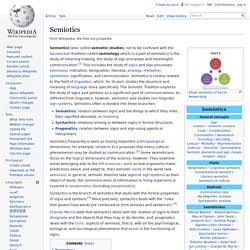
They examine areas belonging also to the life sciences – such as how organisms make predictions about, and adapt to, their semiotic niche in the world (see semiosis). System Diagramming Resources (T552) Nature of Change. {To download a Word version, click here.}
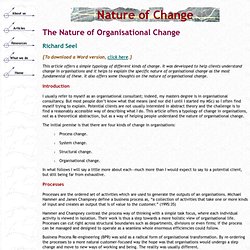
This article offers a simple typology of different kinds of change. It was developed to help clients understand change in organisations and it helps to explain the specific nature of organisational change as the most fundamental of these. It also offers some thoughts on the nature of organisational change. Introduction. Appreciative Inquiry. What is Appreciative Inquiry?
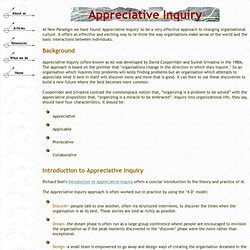
By Joe Hall and Sue Hammond also offers a reasonably brief and readable introduction to the principles and practice of AI. Richard Seel: "We use AI principles quite a lot in our work – for instance, when a team I was working with suddenly had the plug pulled on their project they were very angry and depressed. Home Page of Mel Conway's Site. Author's note 33 years after publication: Perhaps this paper's most remarkable feature is that it made it to publication with its thesis statement in the third-last paragraph.

To save you the trouble of wading through 45 paragraphs to find the thesis, I'll give it to you now: Any organization that designs a system (defined more broadly here than just information systems) will inevitably produce a design whose structure is a copy of the organization's communication structure. This turns out to be a principle with much broader utility than software project management, where references to it usually occur. I invite you to read the paper, then look around to find applications. My current favorite is the complex of social issues encompassing welfare, access to labor markets, housing, education, and drugs.
After reading the paper, think about how the structures of our various governments affect their approaches to this system. The Cluetrain Manifesto.